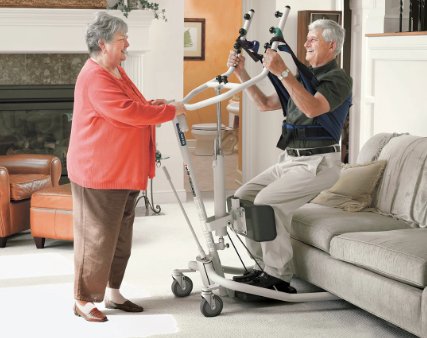A Guide to Renting a Hoyer Lift for Home Use

Introduction
Caring for a loved one with mobility challenges can be physically demanding. A Hoyer lift, also known as a patient lift, can significantly ease the process by providing safe and efficient transfers. This guide will walk you through everything you need to know about Renting a Hoyer lift for home use, ensuring you make an informed decision that best suits your needs.
Understanding Hoyer Lifts
What is a Hoyer Lift?
A Hoyer lift is a medical device designed to assist caregivers in transferring patients with limited mobility from one place to another, such as from a bed to a wheelchair. It uses a sling attached to a hydraulic or electric lift mechanism to move the patient safely.
Types of Hoyer Lifts
- Manual Hoyer Lifts: Operated by a hydraulic pump, these lifts require manual effort to raise and lower the patient.
- Electric Hoyer Lifts: Powered by a battery or electricity, these lifts offer a more effortless and smoother transfer process.
Components of a Hoyer Lift
- Base and Wheels: Provide stability and mobility.
- Mast and Boom: The vertical and horizontal components that support the sling.
- Sling: The fabric support that holds the patient during transfers.
- Hydraulic Pump or Motor: Mechanism for raising and lowering the boom.
Benefits of Using a Hoyer Lift at Home
Enhanced Safety
Hoyer lifts reduce the risk of injury for both the patient and caregiver during transfers, ensuring a safer environment.
Improved Comfort
The use of a sling provides a more comfortable and secure transfer experience for the patient.
Increased Independence
By enabling easier transfers, Hoyer lifts can increase the patient’s sense of independence and dignity.
Reduced Physical Strain
Caregivers can perform transfers with minimal physical effort, reducing the risk of back injuries and other physical strains.
How to Choose the Right Hoyer Lift for Home Use
Assessing Patient Needs
Consider the patient’s weight, mobility level, and specific transfer needs to determine the most suitable type of lift and sling.
Evaluating Space Constraints
Ensure you have enough space in your home to maneuver the lift comfortably, especially in tight areas like bathrooms and bedrooms.
Checking Weight Capacity
Different lifts have varying weight capacities. Ensure the lift you choose can safely accommodate the patient’s weight.
Considering Power Options
Decide between manual and electric lifts based on your preference for ease of use and budget.
Reviewing Safety Features
Look for lifts with features such as emergency lowering, locking casters, and padded slings for added safety and comfort.
Renting vs. Buying a Hoyer Lift
Cost-Effectiveness
Renting a Hoyer lift can be more cost-effective for short-term needs or temporary recovery periods, while buying may be a better option for long-term use.
Maintenance and Repairs
Rental services typically include maintenance and repair services, reducing the hassle and cost of upkeep.
Trial Period
Renting allows you to try different models to find the one that best suits your needs before committing to a purchase.
Cost of Renting a Hoyer Lift
Rental Rates
Rental rates can vary based on the type of lift, rental duration, and location. On average, you can expect to pay between $100 and $200 per month for a standard manual lift and $200 to $400 for an electric lift.
Additional Costs
Be aware of additional costs such as delivery fees, setup charges, and insurance.
Insurance Coverage
Check with your insurance provider to see if they cover the cost of renting a Hoyer lift, as some policies include durable medical equipment.
Finding a Reliable Rental Service
Researching Providers
Look for reputable medical equipment rental companies with positive reviews and a wide range of lift options.
Inquiring About Services
Ask about delivery times, setup assistance, maintenance services, and customer support to ensure a smooth rental experience.
Comparing Quotes
Request quotes from multiple providers to compare prices and services before making a decision.
Setting Up and Using a Hoyer Lift at Home
Preparing the Space
Ensure the area is clear of obstacles and has enough room to maneuver the lift.
Assembling the Lift
Follow the manufacturer’s instructions or seek assistance from the rental service to assemble the lift correctly.
Training and Safety
Familiarize yourself with the operation of the lift and practice safe transfer techniques. Some rental services offer training sessions.
Regular Maintenance
Perform regular checks to ensure the lift is functioning properly and report any issues to the rental provider immediately.
FAQs
Can I rent a Hoyer lift for a short period?
Yes, most rental services offer flexible rental terms, allowing you to rent a Hoyer lift for as short or as long as needed.
What is the weight limit for a Hoyer lift?
Weight limits vary by model. Standard lifts typically support up to 400 lbs, while bariatric models can handle up to 600 lbs or more.
Do I need a prescription to rent a Hoyer lift?
While a prescription is not always required, some insurance companies may require one for coverage. Check with your rental provider and insurance company.
Can I move the Hoyer lift between different rooms?
Yes, Hoyer lifts are designed to be mobile. Ensure the lift you choose can navigate through doorways and tight spaces in your home.
How do I clean the sling?
Most slings are machine washable. Follow the manufacturer’s cleaning instructions to ensure proper maintenance and hygiene.
Is it difficult to operate a Hoyer lift?
With proper training and practice, operating a Hoyer lift becomes straightforward. Many rental services offer training and instructional materials.
Conclusion
Renting a Hoyer lift for home use can greatly enhance the safety and comfort of patient transfers, providing significant benefits for both the patient and caregiver. By understanding the different types of lifts, evaluating your needs, and choosing a reliable rental service, you can ensure a positive experience. This guide aims to provide you with the essential information needed to make an informed decision and improve the quality of care in your home.






